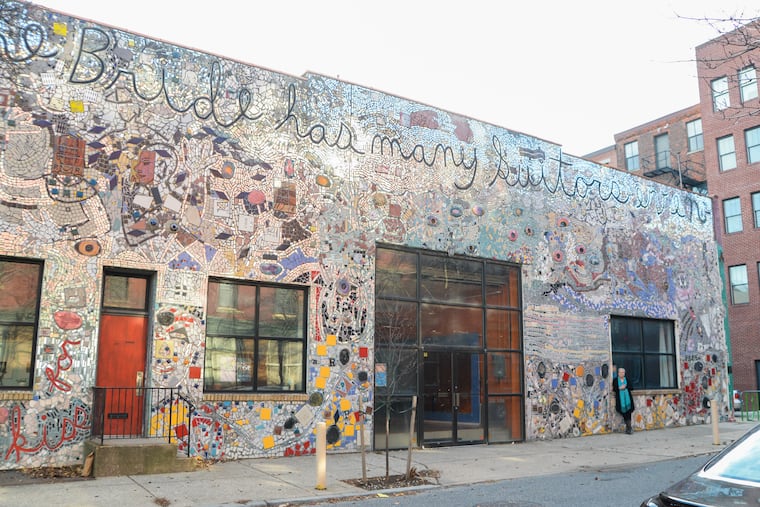Painted Bride sale may proceed, judges say, but Isaiah Zagar murals may not be doomed
The building is now under an agreement of sale with Groom Investments.

A Commonwealth Court panel has ruled that the Painted Bride Art Center may proceed with the sale of its building, but the decision may not spell destruction for the exterior’s mosaic by local artist Isaiah Zagar.
Reversing a previous ruling by Philadelphia Orphans' Court, the three-judge appellate court panel this week determined that there is nothing to stop the Painted Bride from selling its Old City building to developers.
The decision would seem to throw open the fate of the exterior’s mosaic by Zagar. But, several sources now say, sometime after the Orphans' Court issued its ruling in September 2019, the Painted Bride building was remarketed with the condition that the facade of the building be preserved.
“Therefore, any deal that might be in place right now is likely there because the developer was willing to preserve the facade,” said Dan Mayock, who, as managing director of SSH Real Estate, has been overseeing the marketing of the property.
The building is now under an agreement of sale with Groom Investments, said a lawyer for the pending buyers, though no one from Groom Thursday would affirm an intention to keep the 7,000-square-foot mosaic.
“We are pleased with the opportunity to move forward with the acquisition of the property," said a statement from lawyer Richard B. Pressman. "We have tremendous respect for the Painted Bride organization and the many artists and patrons that they serve. They will now be able to take on the next phase of their mission. Our new development will be sure to honor the fabric of the neighborhood and the spirit of the City of Philadelphia.”
The legal wrangling stemmed from the decision by the Painted Bride to pivot away from occupying its own building, with performance and other spaces, to becoming an organization that instead supports artists and their activities across the city’s neighborhoods. Zagar and others opposed the sale, citing the impending destruction of the mosaic and the loss of the Bride as an arts venue.
Painted Bride executive director Laurel Raczka said she was hesitant to say that the dispute with Zagar was over.
“This has been three years and I have thought ‘win-win’ before, and so I am being cautious,” she said.
A lawyer for Zagar said they were considering their options.
“We were disappointed,” said Jerrold “Jim” Moss. “We don’t believe the court gave proper weight to the public interest in maintaining the mosaic."
The earlier Orphans' Court decision had noted that “many individuals consider [the mosaic] to be a true treasure,” wrote Judge Matthew D. Carrafiello. The ruling put on hold a sale of the building to Groom, which had envisioned building residences on the site.
Tuesday’s decision by Commonwealth Court, however, found that the lower-court ruling had read into the Painted Bride’s original articles of incorporation something that did not exist — “a duty to the Mosaic itself,” as they put it.
The articles set up the group to promote painting, sculpture, drama, music, dance, and poetry, but the mission did not extend to Zagar’s mosaic, the judges found. “It is the sale of its property, including the Mosaic, that will result in the liquidity necessary for Painted Bride to continue to fulfill its charitable purpose,” wrote Judge J. Andrew Crompton.
The Painted Bride opened in a gallery space on South Street in 1969 and moved into its current site at 230 Vine St. in 1982. Zagar began working on his mosaic in stages beginning in 1991, completing it in 2000.
“Given Zagar’s lack of ownership in the Mosaic and lack of any contractual agreement with Painted Bride that the Mosaic would be preserved indefinitely, along with the lack of any indicia that Painted Bride otherwise had an obligation in its Articles of Incorporation, or in law, to maintain the Mosaic, the Orphans' Court inappropriately affixed an impermissible restriction on Painted Bride’s ability to effectuate the sale of its property to Buyer,” Crompton wrote.
Raczka said that the Bride’s shift to not being tied to a physical space had only been affirmed with the pandemic, which has shut down arts facilities everywhere and created enormous uncertainty about the future of the entire sector.
"It made our decision all the more real,'' she said. “We are going to just keep on doing what we can programmatically, and that is exciting.”